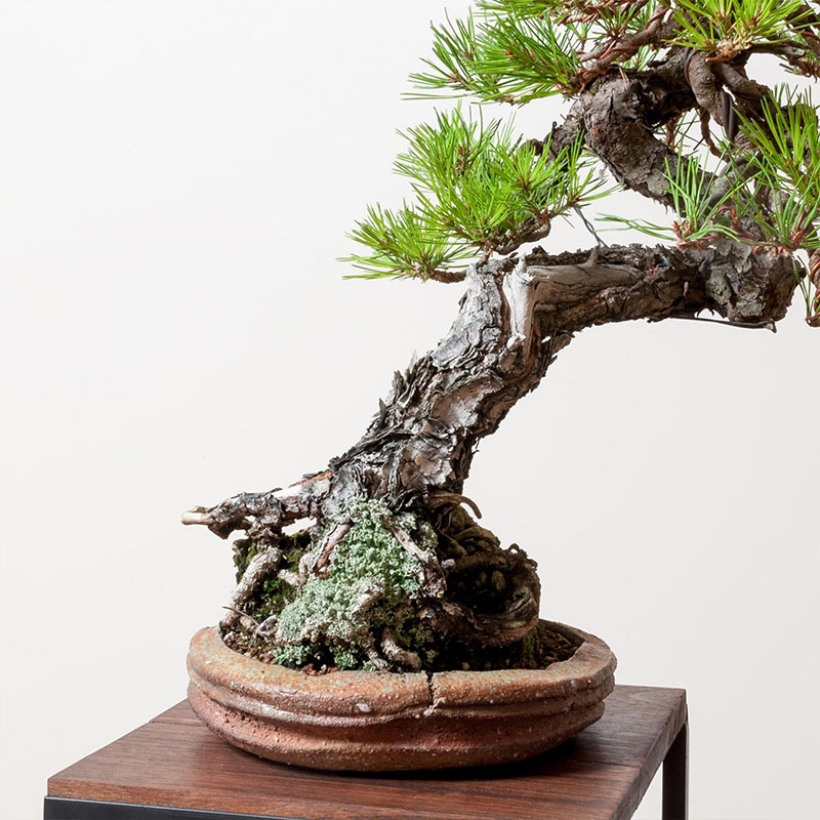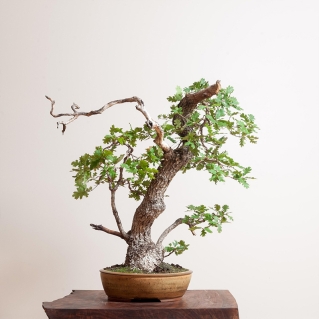Japanese Red Pine Bonsai

General Information
Japanese red pine—Pinus densiflora—is one of the pillar species of bonsai in the traditional practice in Japan. This elegant, informal, and artistic free-expression form of the tree can be considered the queen of bonsai.
Although capable of producing two flushes of growth in a single season, the foliage on this two-needle pine is light and soft. The Japanese red pine is prized for its airy, delicate appearance.
While the number of natural interpretations in the modern world of red pine has significantly decreased, its presence as a bonsai subject has never been more sought after or in demand.

Caring for Japanese Red Pine Bonsai
Watering
Being a foothill pine, Japanese red pine bonsai has moderate watering requirements compared to Japanese black pine. It is tolerant of dryness and needs to thoroughly dry out between waterings.
Be careful not to over-water. On the balance of water and oxygen, Japanese red pine bonsai sits more on the oxygen side than the water-heavy side. Good drainage is required, and too much water can make the needles grow longer than necessary while the second flush is developing.
Sun Exposure
Like most pines, Japanese red pine loves full sun. This helps the first and second flush of growth develop.
Give it as much sun as you can to allow for:
● Shorter needles
● Tighter internodes
● Prolific back-budding; and
● Production of adventitious areas for growth
Temperature
Japanese red pine bonsai is tolerant of temperatures over 100°F, but not as tolerant of heat as the Japanese black pine. When you add high humidity with heat, Japanese red pine does not thrive well.
This pine finds itself in its wheelhouse of existence in temperatures in the high 80s and 90s.
Contrary to Japanese black pine, Japanese red pine is quite tolerant of colder temperatures. As a foothill pine, it is the multi-flush pine for cooler climates, as it can be found in the higher elevations of the Japanese Alps.
In areas where black pine is difficult to produce two flushes, Japanese red pine can successfully produce two flushes of growth—making it unique as a multi-flush pine in areas with a shorter growing season.
In a containerized environment, small and medium Japanese red pine bonsai are tolerant of colder temperatures depending on the soil mass, but we recommend not letting them get below 15°F.
Larger trees can go well below 0°F as long as they are in the ground.
Fertilizing
Fertilization for Japanese red pine is timed on the multi-flush calendar. You will build the energy from March to April, April to May, and May to June. We recommend two applications at least—if not three—in warmer areas to build up strength.
Decandling should take place in June. Then, wait to fertilize until the middle of September when the second flush has hardened. You will fertilize again in the fall with two applications, September to October and October to November.
Pruning
For structural pruning and creation, spring—before growth begins—is the primary time in the year when you can do significant structural work and branch removal.
Where you would typically handle a lot of structural work in the early fall with other bonsai species, doing so would disrupt the multi-flush nature of growth, even if you’re not decandling.
When pruning for refinement, decandling should happen in summer, around the beginning of June in the Northern hemisphere. This incites a second flush of growth. In late fall, you will do shoot selection and needle plucking to balance energy.
Wiring
Wiring and styling your Japanese red pine can happen in multiple seasons. However, it’s best to shape your bonsai when it’s young, as young branches are more flexible.
Structural wiring can be done in early spring before it starts to grow or in fall during the shoot selection process. Fall is a good time to wire and refine the branching of this specific species.
Ensure that any wiring or bending you do does not disrupt the flow of water from the roots.
Repotting
Like any pine, Japanese red pine’s strength comes from the roots. When repotting, it’s imperative not to reduce too much root mass.
Since red pine bonsai comes from dry, arid environments, it does not move water or create sugars and starches rapidly. If you take too much root off in the repotting process, red pine will still push a flush of growth based on resin stored in the system sap that perpetuates energy, but it cannot generate enough sugars and starches to rebuild the root system.
Once this species has been repotted, let the soil dry so new roots can be produced. An akadama-lava-pumice soil mixture best supports the needs of Japanese red pine bonsai—allowing oxygen to penetrate the roots.
For Japanese red pine in particular, unless it’s pushing a vigorous spring flush of growth after repotting, we recommend taking the year off of decandling.
Propagation
Japanese red pine is propagated by seed.
Pests/Disease
Japanese red pine tends to be relatively disease and pest free if it’s kept healthy.
However, much like any multi-flush pine, you may find pests in your red pine, such as:
● Spider mites
● Aphids
● Scale; or
● Caterpillars
Red pine can also suffer from diseases such as Dothistroma needle blight.
Japanese Red Pine Bonsai FAQS
There is no time of the year when you’re going to have more flexibility. But, there are genetic differences in one red pine to another that makes some red pine more flexible than others.
Japanese red pine is known as the “glass pine” because of its brittle nature. It can be very fragile—no matter the time of year—and you can always assume it will be incredibly brittle.
Raffia can be a good tool for Japanese red pine to provide some compression and help support bending.
Be sure to exercise caution when bending red pine. It will destroy red pine’s bark, which is highly valued. The bark will return rapidly once the tree becomes healthy.
Absolutely. The thinner needles of red pine mean they don’t have as much photosynthetic surface area as black pine.
Therefore, when we pluck needles to distribute energy, we need to leave more needles per shoot on a red pine than on a black pine.
Like any pine, Japanese red pine can trunk up and grow relatively fast, if provided with the right resources.
When compared to black pine in more coastal conditions, red pine does not transpire as quickly. It doesn’t create sugars and starches or build vascular tissue as rapidly. This means when compared to black pine, red pine does grow and thicken more slowly.






